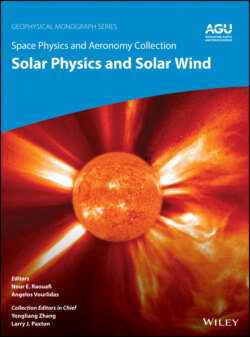Читать книгу Space Physics and Aeronomy, Solar Physics and Solar Wind - Группа авторов - Страница 18
1.3.3. Solar Wind Interaction Regions
ОглавлениеThe rotation of the Sun and its associated solar wind sources such as coronal holes can result in the radial alignment of the fast and slow solar wind. A kinematic gathering of the interplanetary plasma when the fast wind catches up the slow stream, inducing an increase in plasma density near the stream interface. When the solar wind behind is much faster than the solar wind ahead, it can compress the slow wind before it reaches 1AU (as seen in Figure 1.7). When a compression region is measured over at least two consecutive solar rotations it is called a Corotating Interaction Region (CIR), otherwise one refers to simply a Stream Interaction Region (SIR; L. Jian et al., 2006). The interaction between fast and slow solar wind that creates a CIR is illustrated in Figure 1.10. Detailed descriptions of CIRs can be found in Gosling and Pizzo, 1999, and in Pizzo, 1982. As seen in the left‐hand schematic of Figure 1.10, the interaction region forms, like the background solar wind, an Archimedian spiral rooted at the Sun. In three dimensions, the stream interface can be titled as it responds to the tilt of the solar magnetic dipole. Figure 1.10 illustrates how plasma flows are typically deflected inside CIRs in latitude as well as in longitude (Pizzo, 1982).
CIRs and SIRs can be more complex structures than spirals; they are composed of a multitude of smaller interaction regions that merge during the wind propagation to 1 AU. This is a consequence of the variability of the slow wind released by helmet streamers (as discussed in Section 1.2.2). Strong dynamic effects associated with the rise in total pressure inside the SIRs and CIRs are most apparent beyond 1 AU, where forward/reverse shock pairs (Lee, 2000) can bound the interaction region.
Figure 1.10 Two schematics illustrating CIRs where the fast solar wind catches up and compresses the slow solar wind. The left‐hand schematic is a view from solar north, and the right‐hand schematic illustrates the 3D interaction between flows when the stream interface is inclined relative to the north‐south direction.
(Source: Figure taken from Owens & Forsyth, 2013. © 2013, Springer Nature.)
The interaction of the fast and slow solar winds, particularly in SIRs and CIRs, reduces the range of velocities of the solar wind. The slow solar wind has typical slow speeds between 300 km/s and 450 km/s. Between 0.3 and 0.4 AU, where interaction regions have not yet formed to accelerate the slowest plasma, the slow solar wind exhibits speeds less than 300 km/s nearly 10% of the time. This very slow solar wind can have speeds as low as 200 km/s inside 0.7 AU, a speed never measured at 1 AU. Wind speeds less than 300 km/s are very seldom measured in situ at 1 AU but have been extensively observed in white‐light images (Rouillard, Davies, et al., 2010). This very slow wind typically has lower temperatures and higher densities than the regular slow solar wind. The properties and the source of this VSSW as well as its solar cycle variability were analyzed by Sanchez‐Diaz et al. (2016).
